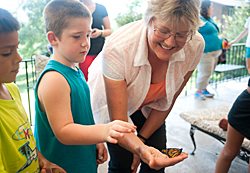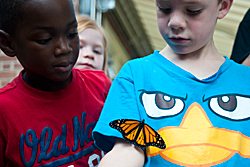On August 20 and 27, Mrs. Laurie Roelofs and a few children from the Child Development Lab released 36 monarch butterflies into the world. The event was part of an ongoing effort to increase the monarch population, which has been declining annually due to loss of habitat.
With support from Sustainable Berea and University of Kansas-based Monarch Watch, Laurie is continuing work she began as a kindergarten teacher in Haverford, PA, more than fifteen years ago.
 Hatching and raising the butterflies from the president’s house, Laurie kept them in netted, transparent cages before sending them on an eight-to-nine month journey to the warm Trans-Mexican Volcanic Belt in northwest Mexico.
Hatching and raising the butterflies from the president’s house, Laurie kept them in netted, transparent cages before sending them on an eight-to-nine month journey to the warm Trans-Mexican Volcanic Belt in northwest Mexico.
Releasing butterflies with local children has become a regular event. “It is an early and very important learning experience for the children,” she said, claiming that educating children is the foundation for communitywide awareness of the monarch phenomenon.
Laurie also helped establish a new monarch way station near the Edwards building. The way station is a small plantation of milkweed upon which monarchs can lay their eggs. During the dedication on May 29, Laurie gave away about forty milkweed plants to several members of the community in hopes people will plant them in their yards.
“I just want the monarchs to survive,” she said. “They are very beautiful and such an incredible process to watch.”
 Monarchs are best known for their annual migration from east of the Rocky Mountains to Mexico and southern California. Before their migration, they pass through several stages of life. In early spring, the females lay their eggs on milkweed plants, which also serve as food sources for the larva. Once the larvae is hatched four days later, it grows seven to eight times its original size before it forms a pupa from which the adult butterfly emerges.
Monarchs are best known for their annual migration from east of the Rocky Mountains to Mexico and southern California. Before their migration, they pass through several stages of life. In early spring, the females lay their eggs on milkweed plants, which also serve as food sources for the larva. Once the larvae is hatched four days later, it grows seven to eight times its original size before it forms a pupa from which the adult butterfly emerges.
Between spring and fall, there are four generations of monarch butterflies, which typically live between two and five weeks. The fourth generation, however, born in September and October, live eight to nine months, long enough for a return migration to Mexico.
Berea is in the eastern region of the migration route to Mexico. However, due to the absence of milkweed, likely related to over-zealous weeding and weed-killing chemicals, the number of the migrating monarchs has declined over time as well.
photography by Shay Smith, ’15